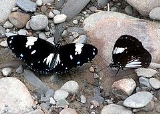
Euploea radamanthus
Encyclopedia
The Magpie Crow is a butterfly found in India that belongs to the Crows and Tigers, that is, the Danaid group of the Brush-footed butterflies
family.
Race ramsayi, Moore (Eastern Himalayas).—Differs in being on the whole larger, with the white markings of great width, in the female almost entirely filling the cell in the hind wing. In both sexes streaks are always present in interspaces 3 and 4 of the hind wing, while the sub-terminal and terminal series of spots on that wing are generally complete. The female in all the specimens I have examined has a decided blue gloss on the apical half of the fore wing.
Nymphalidae
The Nymphalidae is a family of about 5,000 species of butterflies which are distributed throughout most of the world. These are usually medium sized to large butterflies. Most species have a reduced pair of forelegs and many hold their colourful wings flat when resting. They are also called...
family.
Description
Male Fore wing: dorsum and termen very convex ; costa arched. Female Fore wing: differs only in being narrower and the dorsum sinuous. Hind wing in both sexes: costa and termen strongly curved, forming together half of an ellipse of which the straight dorsal margin is the chord. Male. Upperside black, the fore wing with a brilliant blue gloss throughout, the base brown; hind wing: the upper portion silky hair-brown, the disc and terminal margin shot with blue. Fore wing : a very large, irregular, white spot filling the apex of the discoidal cell, three elongate spots divided by the nervures above and one or two small white spots below, the whole forming an irregular oblique bar ; a large sub-terminal blue spot in interspace 2 and smaller similar spots in interspaces 4-7; finally a line of 3 or 4 small terminal blue spots near the tornus : all these blue spots occasionally white-centred. Hind wing: broad white streaks in interspaces la, 1b, 1 and 2, a spot (sometimes absent) at base of interspace 3, another (but rarely) at base of interspace 4, one or two discal blue spots and very incomplete subterminal and terminal series of similar spots. Underside hair-brown, the markings as above but more complete .and larger; on the hind wing there are in addition one or two spots or streaks in the cell and on the disc beyond it. Female Upperside pale umber-brown, the apical half of the fore wing with or without blue gloss; markings similar to those of the male, but all of them white and somewhat larger, especially the two spots at the lower end of the oblique baron fore wing ; on the hind wing there are in addition three white streaks in the cell with two or three spots beyond, the subterminal and terminal series of spots white and generally complete. Underside similar, the markings broader. Antenna black ; head, thorax and abdomen in male bluish black, in female cinereous ; in both sexes the palpi and thorax beneath spotted with white, the abdomen transversely barred with the same colour.Race ramsayi, Moore (Eastern Himalayas).—Differs in being on the whole larger, with the white markings of great width, in the female almost entirely filling the cell in the hind wing. In both sexes streaks are always present in interspaces 3 and 4 of the hind wing, while the sub-terminal and terminal series of spots on that wing are generally complete. The female in all the specimens I have examined has a decided blue gloss on the apical half of the fore wing.
See also
- Danainae
- NymphalidaeNymphalidaeThe Nymphalidae is a family of about 5,000 species of butterflies which are distributed throughout most of the world. These are usually medium sized to large butterflies. Most species have a reduced pair of forelegs and many hold their colourful wings flat when resting. They are also called...
- List of butterflies of India
- List of butterflies of India (Nymphalidae)

